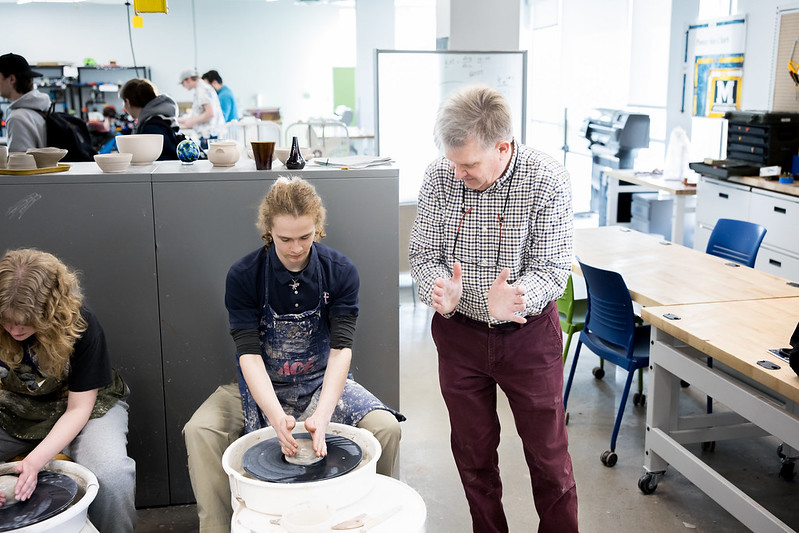Blending Creativity and STEM: Mines Faculty Launch Art-Infused Engineering Curriculum for High Schools

By blending art and science through hands-on learning, South Dakota Mines is helping high schoolers and teachers see STEM in a new light—one that’s both accessible and inspiring.
The idea for integrating a ceramic STEM module into high school curriculum took root after Michelle Crane, a chemistry teacher at Douglas High School in Box Elder, spent last summer collaborating with Dr. Katrina Donovan from Mines through a NASA Research Experience for Teachers (RET) program.
Their partnership sparked a bigger question: Why not bring the university’s cutting-edge technology and expertise directly into local high school classrooms—creating a new framework that bridges art, science and engineering education?
That idea turned into a pilot program last fall featuring a ceramic STEM module for Crane’s high school chemistry courses, which follow the learning objectives established by the South Dakota Educational Association.
“One of our goals was to support the learning objectives that teachers have to follow in courses like chemistry and physical science, and to leverage the skills and tools we have at Mines that with the high school curriculum,” said Donovan, a senior lecturer in the Mines Department of Materials & Metallurgical Engineering.
The foundation of the pilot curriculum was inspired by Crane’s summer research, where
she explored ceramic glaze formulations using 100% locally sourced materials from the Black Hills.
Her focus on both clays and glazes gave rise to a hands-on learning experience for
her students.
ceramic glaze formulations using 100% locally sourced materials from the Black Hills.
Her focus on both clays and glazes gave rise to a hands-on learning experience for
her students.
“Some of the most poignant lessons I took from my own experience at Mines was the importance of investment in fundamental research and the power of collaboration,” Crane said. “At the secondary level, we often focus on science concepts and limit our instruction on being curious. Experimental design and pursuing a line of knowledge that reveals itself as we conduct research establishes a foundation for problem solving applicable in many aspects of student's lives.”
Before visiting South Dakota Mines, students studied the chemistry behind clay bodies and glazes. Once on campus, they examined the microstructure of their samples using a scanning electron microscope, toured the Arbegast Materials Processing and Joining (AMP) Laboratory, and put their knowledge of clay processing into practice through wheel throwing.
Donovan, who recently presented a paper on the pilot program at the American Society for Engineering Education’s annual conference, said the project objectives for the on-campus learning modules included supporting local STEM teachers and helping with their course learning objectives, creating an opportunity for high school students to do hands-on learning on a university campus, and creating a program that balances technical classroom content with a fun kinesthetic approach to STEM.
Last spring, the pilot program with Douglas High School expanded to include two additional local high schools. Dr. Jon Kellar, Mines professor of materials and metallurgical engineering, assisted with the program, providing outreach to an advanced art class at St. Thomas More and an organic chemistry class from Rapid City Central High School.
The students completed rotations between glass blowing, pottery and blacksmithing, always learning the science behind the art.
“The STEAM concept is not new. It came about around 2007 or 2008, the same time we were doing blacksmithing. But the levels of integration we’ve done, and involving artists, like Dr. Matthew Whitehead (Mines senior lecturer and director of the Apex Gallery on campus) is unique,” Kellar said. “We really try to make sure what we do is hands-on and they can take something home with them whether it is a tile, pot, blacksmithing hook and in the case of ceramics we work to connect it with the local minerals.”
As the program continues, its success lies in the collaboration between university faculty, local educators and the creative energy of students.
“I want my students to understand the whole view. I want them to know that science disciplines and creative pursuits overlap, and should,” Crane said. “Those overlaps are often lost in the way we normally set up classes at the secondary level. Integrating inherently creative practices that inspire a desire to understand more rigorous content is deeply effective for high school students. It is both a hook and a doorway to lifelong learning.”